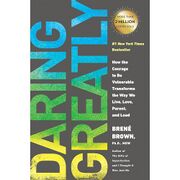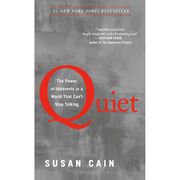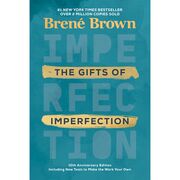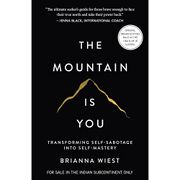Can't Hurt Me
🍎 Healthy brain food
"We’re either getting better or we’re getting worse."
— David Goggins, Can't Hurt Me (2018)
Introduction
| Can't Hurt Me | |
|---|---|
 | |
| Full title | Can't Hurt Me: Master Your Mind and Defy the Odds |
| Author | David Goggins |
| Language | English |
| Subject | Memoir; Mental toughness; Personal development |
| Genre | Nonfiction; Memoir; Self-help |
| Publisher | Lioncrest Publishing |
Publication date | 4 December 2018 |
| Publication place | United States |
| Media type | Print (hardcover, paperback); e-book; audiobook |
| Pages | 363 |
| ISBN | 978-1-5445-1228-0 |
| Goodreads rating | 4.3/5 (as of 6 November 2025) |
| Website | lioncrest.com |
Can't Hurt Me is a memoir–self-help book by former Navy SEAL David Goggins, published on 4 December 2018 by Lioncrest Publishing.[1][2] The book popularizes Goggins’s “40% Rule” and the ethic of “callousing the mind,” presenting a system for pushing past perceived limits.[2] Reviewers describe the voice as direct, conversational, and often raw.[1] The hardcover is organized into eleven chapters.[3] By April 2021, Business Insider reported more than 3 million copies sold (including 900,000 in the first four months).[4] By December 2022, Publishers Weekly tallied 529,000 U.S. print copies via BookScan.[5] The publisher markets the title as a New York Times, Wall Street Journal, and USA Today bestseller, and the audiobook has appeared on Apple Books’ Top 10 lists in 2024.[2][6]
Chapter summary
This outline follows the Lioncrest Publishing hardcover edition (2018; ISBN 978-1-5445-1228-0).[7] Release date and page count per review.[1] Publisher imprint page.[2]
🎲 1 – I should have been a statistic. Late nights at a Buffalo roller rink run by his father set the tone for childhood—music thumping after midnight while a small boy handled skates and learned to stay invisible. Violence at home escalated until his mother fled with him to Brazil, Indiana, where safety brought new problems: he arrived at school behind, stuttered, and struggled to concentrate. Racial harassment in the small Midwestern town hardened each school day and made walking the halls feel like moving through a gauntlet. Grades slipped, confidence cratered, and shortcuts like cheating crept in because passing felt like survival, not learning. The cumulative stress left his attention scattered and his self-image brittle, a pattern that made future failure feel inevitable. Everything bent toward a decision point: accept the trajectory or challenge it. Adversity compounds—but so can agency—once the facts are faced without flinching. Naming the reality of abuse, fear, and poor performance begins the book’s central project: callousing the mind through deliberate honesty and disciplined action.
🩹 2 – Truth hurts. A warning from school that graduation was at risk pushed him into a bathroom confrontation with the mirror, where he stripped away jokes and bravado and wrote blunt Post-it notes about his lies, weaknesses, and next steps. That “Accountability Mirror” became a daily ritual: specific tasks to study, train, and show up differently replaced vague goals. He changed his presentation—cleaned up, set earlier alarms, and carved out quiet hours to focus—using the mirror as both scoreboard and coach. Each note tightened the link between identity and behavior; when he failed, the mirror forced a rewrite rather than a rationalization. Progress came in unglamorous increments: more time with textbooks than with friends, more early runs than late nights, more reps than excuses. Self-deception erodes capacity; unfiltered feedback restores it. Radical self-honesty paired with small, repeated corrections turns motivation into habit and anchors the book’s theme of an armored mind.
🧗♂️ 3 – The impossible task. Years later, he was a 297-pound night-shift exterminator when a Discovery Channel segment on BUD/S Hell Week jolted him awake; the next calls to Navy recruiters ended with hang-ups until one offered a narrow window. To ship out, he had less than three months to drop 100-plus pounds and meet strict weight standards, a demand that left no room for half measures. He built his days around movement and recovery, training for hours while cutting needless calories, and he studied to raise the ASVAB score he had once failed so he could qualify. The clock was the tyrant and the teacher: if he paused, he fell behind; if he moved, he inched closer. Soreness and setbacks arrived fast, but a simple rule—keep training—kept the math working in his favor. By the deadline he had carved off the weight and secured a slot for BUD/S, trading the night route for the beach at Coronado. A hard external constraint created urgency, and a new identity—someone who does hard things daily—sustained it. This is where “impossible” becomes a plan, and the mind toughens to meet it.
⚔️ 4 – Taking souls. During BUD/S Hell Week at the Naval Special Warfare Center in Coronado, California—a five-and-a-half-day stretch with fewer than four hours of sleep—Goggins and his boat crew sprinted the soft sand with an inflatable boat over their heads, churned through the nighttime surf, and raced other teams for time. Instructors kept the pace brutal with evolutions like boat carries and log PT, where precision and teamwork mattered as much as strength. Morale rose and fell with every cold immersion and missed cutoff, and that volatility opened the door to a mental tactic he called “taking souls.” He set out to outperform so decisively—finishing first in races, volunteering for extra work, smiling under stress—that instructors and classmates had to recalibrate what was possible. Each visible win fed the crew’s energy and made the next rep lighter. By week’s end the contest felt less about beating other men and more about seizing agency from suffering itself. Disciplined overperformance becomes a social lever that shifts the psychological balance of a hard environment. With attention fixed on execution, repeated proof of capability expands the limits the mind enforces.
🛡️ 5 – Armored mind. After Hell Week, training settled into a grind at Coronado: timed four-mile beach runs, obstacle-course repeats, and two-mile ocean swims with fins, all under watchful instructors. Fatigue exposed sloppy thinking, so he drew on “callousing the mind,” treating past abuse, failures, and lonely practice hours as proof he could carry more today. Instead of grand goals, he stacked micro-targets—the next buoy, the next lap, the next clean repetition—so progress stayed measurable when motivation faded. A mental ledger of hard things already done was replayed before cold surf entries and evaluation days, turning memory into fuel. Mistakes brought extra work, and sleep ran thin, which made small rituals—gear checks, foot care, quiet breathing—anchors when emotions spiked. The armor formed not from denial but from repeated voluntary contact with adversity until it lost its power to intimidate. Accurate self-talk paired with controlled exposure rewires what feels survivable, so the next shock lands on thicker callus instead of raw nerves.
🏆 6 – It's not about a trophy. In November 2005 at Mission Bay Park in San Diego, he toed the line at the San Diego One Day, a 24-hour ultramarathon on a flat one-mile asphalt loop at Hospitality Point. The brief was simple: cover at least 100 miles within the cutoff to prove he belonged at bigger races. Early laps felt routine, but blisters, cramps, and nausea turned the night into a test of problem-solving—salt and fluids, shoe changes, and relentless forward motion. He broke the event into tiny segments—five laps, then five more—reaching into a “cookie jar” of prior hard wins whenever his body begged to stop. Dawn arrived with the math in reach, and he pushed past the required mark, circling until the clock ended, with 101 miles recorded among 83 finishers.[8] No podium thrill matched the lesson: disciplined pacing and stubborn focus can carry a battered body far beyond its first signal to quit. Success is self-verification rather than hardware. Once the mind is convinced by proof, the body keeps going.
🧠 7 – The most powerful weapon. On Oʻahu’s root-latticed HURT 100 trail race in early 2006, he learned to treat pain as data and pace the night by breaking miles into tiny segments he could win. The terrain and humidity punished every mistake, but the effort hardened him for his real target: Badwater 135 across Death Valley. He formalized a mental model he calls the “governor,” the limiter that keeps performance safe but small, and paired it with the “40% Rule,” the reminder that fatigue signals arrive far earlier than true capacity. Preparation turned ruthless and specific—heat work, hydration drills, and visualization—to strip away excuses. Months later he crossed the Death Valley finish in 30:18:54, fifth overall, proof that the ceiling had moved.[9] Attention to detail—shoes taped, bottles labeled, splits rehearsed—matters only when the mind refuses to negotiate. Exposure to elite peers reset his standards and forced sharper questions of training. Change the story under stress and the body follows; remove the governor, and capacity expands.
🔧 8 – Talent not required. At the Ultraman World Championship in Hawaiʻi, a three-day, ~320-mile triathlon with a 6.2-mile swim, 261.4 miles on the bike over two days, then a 52.4-mile double marathon, he stayed in contention and finished second overall behind Jeff “Landshark” Landauer (24:41:23).[10] The margin exposed preventable errors—gaps in race planning, equipment choices, and pacing. Back home he conducted a ruthless time audit, carving his days into 15- to 30-minute blocks and installing “backstops,” preset checkpoints that force mid-course corrections before small problems compound. The schedule became a standing order: predawn miles, bike commutes, lunch-hour lifts, and evening mobility, with recovery slotted instead of hoped for. Ultra results drew attention beyond racing, and he spoke to students and candidates about preparation beating pedigree. Reliability outproduces raw gift when hours are accounted for and protected. Design a day that drags you toward the work, let repetitions build bankable proof, and discipline scales while talent plateaus.
🦅 9 – Uncommon amongst uncommon. After earning his Trident, he found himself in the Malaysian jungle in 2002, the biggest man on his SEAL team and humping an M60 through heat, mud, and live-fire exercises while the country turned toward Afghanistan. Wanting sharper small-unit skills, he volunteered for Army Ranger School and went from student to peer-evaluated leader in the mountains and the Florida Panhandle swamps, graduating as the Enlisted Honor Man.[11] Returning to the Teams, he tried to impose his relentless standard and learned that intensity without buy-in can split a platoon. He chased harder pipelines—including a Delta selection bid—where a single land-navigation lapse ended the attempt despite elite fitness. Each environment raised the bar and narrowed the margin for ego, pushing him to lead by example, not volume. Excellence is a moving target: yesterday’s best becomes today’s baseline. Be so consistent you set the weather for the group, and be humble enough to keep starting at zero; sustained standards convert ambition into stewardship.
🔁 10 – The empowerment of failure. Under bright studio lights at NBC’s Today Show in New York on 26–27 September 2012, he went after the 24-hour pull-up record—then 4,020—planning a set each minute and fueling with liquids, but he stalled at 2,588 and shut it down.[12] Weeks later at CrossFit Brentwood Hills in Brentwood, Tennessee, he tried again, only to stop at 2,203 when the skin on his palms tore away. In January 2013 he returned to the same Brentwood gym and, over roughly 17 hours, completed 4,030 pull-ups to set the 24-hour mark.[13][14] Each attempt generated timing and recovery data he could use; the third was the sum of those lessons executed without drama. He documented errors, scheduled the next try, and used results—not emotions—to drive the revision. Failure, handled correctly, becomes leverage: a structured review turns pain into instructions and, through iteration under stress, builds an armored mind.
❓ 11 – What if? On late nights, a blank page and a single question—What if?—reframed doubt after setbacks accumulated. He looked backward and forward at once, testing the question against earlier thresholds: the leap from 297 pounds to BUD/S, the failed efforts on national television, and a 2009 heart surgery for a congenital atrial septal defect that forced a hard restart. Instead of searching for perfect conditions, he used “What if?” to convert fear into experiments—short, repeatable blocks of work that either moved the needle or revealed the next constraint. When training stalled, he stripped the day to controllables: early alarms, mobility and rehab work, quiet miles, clean food, and a scoreboard that recorded only the work done. The method is monotonous by design; when excuses rose, the question pointed him back to a small action he could take now. Over time the stack of small proofs changed identity faster than any speech could. The aim is not fearlessness but out-working doubt until it has to reconsider. “What if?” shifts attention from outcomes to process and from imagined limits to tested capacity, keeping the mind on the next rep and the path open beyond pain.
Background & reception
🖋️ Author & writing. Goggins is a retired Navy SEAL whom the publisher describes as the only U.S. service member to complete SEAL training, Army Ranger School, and Air Force Tactical Air Controller training, and a former pull-up world-record holder and ultra-endurance competitor; the book draws on that biography.[2] Outside previously profiled him among its “Fittest (Real) Athletes.”[15] The narrative blends memoir with prescriptive ideas such as the “40% Rule” and “callousing the mind.”[2] Reviewers note a blunt, conversational register with frequent profanity.[1] The hardcover is structured into eleven chapters, tracking a through-line from a violent childhood to military training and ultra-racing.[16] A profanity-filtered “Clean Edition” was issued in 2020.[17]
📈 Commercial reception. Business Insider reported that the book sold over 3 million copies by April 2021, including 900,000 in its first four months.[4] Publishers Weekly, citing BookScan, later noted 529,000 U.S. print copies sold as of December 2022.[5] The audiobook has continued to surface in Apple Books’ Top 10 lists, including January 2024 (U.S.).[6]
👍 Praise. Kirkus called the book “guaranteed to galvanize,” highlighting its candid, take-no-prisoners approach.[1] Men’s Health summarized “10 lessons” from the book, spotlighting tools like the “Accountability Mirror” and the “cookie jar.”[18]
👎 Criticism. Kirkus also flagged that the language is “often raw” and noted some graphic images, which may deter readers.[1] Publishers Weekly observed that “numerous online reviewers complained about the author’s prolific use of profanity,” even as overall sales remained strong.[5] Business Insider noted that some trainers and readers view Goggins’s embrace-suffering message as extreme and “not for everyone.”[4]
🌍 Impact & adoption. The book’s continued presence on Apple Books charts and widespread discussion of the “40% Rule” in endurance and military communities reflect its mainstream reach beyond print.[6]
Related content & more
YouTube videos
CapSach articles
Enjoyed this page?
📚If this page Can't Hurt Me inspired or helped you today, a small coffee helps us keep creating and sharing more. Your support truly matters.👏
References
- ↑ 1.0 1.1 1.2 1.3 1.4 1.5 "CAN'T HURT ME: MASTER YOUR MIND AND DEFY THE ODDS". Kirkus Reviews. 18 December 2018. Retrieved 6 November 2025.
- ↑ 2.0 2.1 2.2 2.3 2.4 2.5 "Can't Hurt Me". Lioncrest Publishing. Lioncrest Publishing. Retrieved 6 November 2025.
- ↑ "Table of Contents: Can't hurt me". Schlow Centre Region Library. Retrieved 21 October 2025.
- ↑ 4.0 4.1 4.2 Hall, Hayden (14 April 2021). "David Goggins turned suffering into a business. Here's how it works". Business Insider. Retrieved 6 November 2025.
- ↑ 5.0 5.1 5.2 Milliot, Jim (16 December 2022). "This Week's Bestsellers: December 19, 2022". Publishers Weekly. Retrieved 6 November 2025.
- ↑ 6.0 6.1 6.2 "US-Apple-Books-Top-10". Winnipeg Free Press (AP). 30 January 2024. Retrieved 6 November 2025.
- ↑ "Can't hurt me : master your mind and defy the odds". WorldCat. OCLC. Retrieved 6 November 2025.
- ↑ "2005 San Diego 1 Day Race Results (24 Hours)". UltraRunning Magazine. Retrieved 6 November 2025.
- ↑ "David Goggins's Race Results". UltraRunning Magazine. Retrieved 6 November 2025.
- ↑ "2006 Ultraman World Championships — Final Results". JTL Timing Systems. Retrieved 6 November 2025.
- ↑ "David Goggins: SEAL, Endurance Athlete". U.S. Department of Veterans Affairs (VA News). 23 July 2020. Retrieved 6 November 2025.
- ↑ "Chief Special Operator (SEAL) David Goggins falls short in pullup world record try". Military Times. 28 September 2012. Retrieved 6 November 2025.
- ↑ "David Goggins breaks Guinness 24-hour pull-up record (4,030)". Vimeo. 2013. Retrieved 6 November 2025.
- ↑ "David Goggins Breaks World Pull-Up Record". CrossFit Brentwood Hills. 23 January 2013. Retrieved 6 November 2025.
- ↑ "Fittest Real Athletes: David Goggins". Outside Online. 15 June 2011. Retrieved 6 November 2025.
- ↑ "Table of Contents: Can't hurt me". Schlow Centre Region Library. Retrieved 21 October 2025.
- ↑ "Can't hurt me : master your mind and defy the odds — Clean Edition". WorldCat. OCLC. Retrieved 6 November 2025.
- ↑ Presto, Greg (7 December 2018). "10 Lessons in Grit and Achievement From Former Navy SEAL David Goggins". Men’s Health. Retrieved 6 November 2025.






